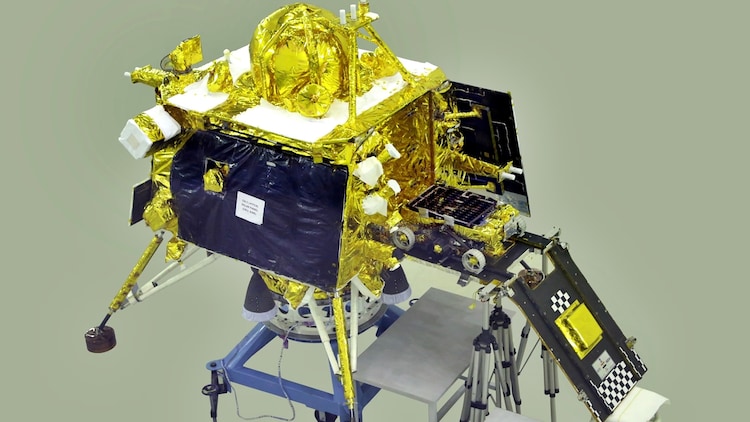
Here's what Chandrayaan-3 will do once it lands on Moon
The lunar mission will target the southern polar region of the Moon, which is a rich reserve for science, and multiple studies and a spectacular suit of instruments are headed to this unexplored world.

In Short
- Chandrayaan-3's propulsion module comes with an exciting new experiment called SHAPE
- Chandrayaan-3's propulsion module comes with an exciting new experiment called SHAPE
- Two important instruments called RAMBHA and Langmuir probe (LP) have also been sent to the Moon
Chandrayaan-3 is on its way to the Moon after leaving Earth's orbit and beginning its trans-lunar journey. The spacecraft is expected to arrive in the Moon's sphere of influence on August 5.
The Indian Space Research Organisation (Isro) is tracking the spacecraft and maintaining constant communication with the probe as it hurtles through the vacuum of space at speeds of over 38,000 kilometers per hour.
The spacecraft is expected to land on the surface of the Moon on August 23, as Isro has said. The lunar mission will target the southern polar region of the Moon, which is a rich reserve for science, and multiple studies and a spectacular suit of instruments are headed to this unexplored world.

Chandrayaan-3 carries a set of eight payloads, including one provided by the American space agency, Nasa. Here's what they will do on the Moon once Chandrayaan-3 lands.
FOLLOW CHANDRAYAAN-3 LIVE UPDATES HERE
HABITABILITY OF EXOPLANETS
Chandrayaan-3's propulsion module comes with an exciting new experiment called SHAPE, short for the Spectro-polarimetry of Habitable Planet Earth.
SHAPE is designed to look for changes that a life-supporting atmosphere makes to the starlight passing through it. This experiment marks a significant leap in the field of Astronomy as it aims to join the ranks of prestigious space agencies like Nasa and ESA in the search for Earth-like, habitable planets.
LISTENING TO LUNAR RUMBLINGS
The Lander Module of Chandrayaan-3 is carrying a special instrument called ILSA, which stands for Instrument for Lunar Seismic Activity. ILSA's main job is to detect and study lunar quakes, which are rumblings under the surface of the Moon.
The Moon is expected to be 1000 times calmer than Earth. Once ILSA confirms this, it opens up exciting possibilities for future exploration. One of the ambitious ideas is to set up a Laser Interferometer Gravitational-Wave Observatory on the lunar surface.
LIGO is an advanced device used to detect and study gravitational waves, which are ripples in space-time caused by massive celestial events like the collision of black holes or neutron stars.
IS THERE PLASMA ACTIVITY ON THE MOON?
Two important instruments called RAMBHA and the Langmuir probe (LP) have also been sent to the Moon. These instruments will conduct experiments to study the near-surface plasma activities on the Moon.
Plasma is a state of matter that consists of charged particles like electrons and ions. This research is crucial for future lunar exploration missions, especially if humans are to stay on the Lunar Surface for extended periods or use it as a base for interplanetary travel. Understanding the phenomenon behind plasma formation and its variations over time is essential for the safety and success of such missions.
Chandra's Surface Thermo-Physical Experiment (ChaSTE) is a critical payload for Chandrayaan-3 that focuses on studying the thermo-physical behavior of the Lunar surface.

ChaSTE's experiments will provide us with valuable data about the Lunar surface's response to temperature variations, shedding light on the processes that have shaped the Moon's terrain over millions of years.
This knowledge will help us make meaningful comparisons with Earth's geological history, offering us a deeper understanding of our own planet's past and how it continues to change.
ESTIMATING LUNAR DYNAMICS
The LASER Retroreflector Array is a crucial payload from Nasa, designed to facilitate real-time distance measurements between the Moon and Earth. By obtaining real-time distance measurements, we can gain a deeper understanding of the Moon's orbital behavior and its influence on Earth.
This knowledge is essential for accurately predicting tidal patterns, understanding ocean currents, and managing coastal environments.
IS LUNAR SOIL USEFUL?
The Alpha Particle X-ray Spectrometer (APXS) and Laser Induced Breakdown Spectroscope (LIBS) are two crucial instruments that serve the purpose of examining the resourcefulness of the Lunar soil.
By studying the Lunar soil's composition, we can gain valuable insights into the Moon's evolutionary history and the processes that shaped it during the formation of our Solar System.
(This is an authored article by Manish Purohit, who has worked on several space fairing missions launched from India)
